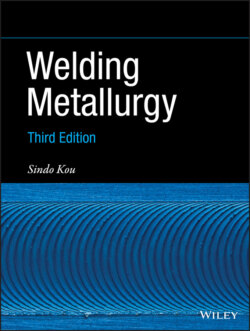Читать книгу Welding Metallurgy - Sindo Kou - Страница 90
3.1.1 Sharp Electrode
ОглавлениеFigure 3.1 shows the body‐fitting coordinate system used in the early work of Tsai and Kou [1] on computer simulation of fluid flow and heat transfer in a gas‐tungsten welding arc. Fluid flow and heat transfer in GTAW has been studied by computer simulation [1–6]. An example is the work by Tsai and Kou [1], which demonstrated the significant effect of the electrode tip geometry on the arc. Although the work did not consider the metal vapor in the arc and the pool surface shape as in the more recent work, it is simple and thus useful for explaining basic fluid flow in the arc before discussing more complicated details.
Figure 3.1 Gas‐tungsten welding arc: (a) sketch; (b) body‐fitted grid system for calculation of heat transfer and fluid flow.
Source: Tsai and Kou [1]. © Elsevier.
Figure 3.2 is a schematic sketch of an arc produced by a tungsten electrode with a sharp tip that is truncated. The polarity is DC electrode negative. The electric current converges from the larger workpiece to the smaller electrode tip. It tends to be perpendicular to the electrode tip surface and the workpiece surface (flat), as illustrated in Figure 3.2a. The electric current induces a magnetic field, which is out of the plane of the page (as indicated by the front view of an arrow) on the left and into the page (as indicated by the rear view of an arrow) on the right. The magnetic field and the converging electric‐current field together produce a downward and inward Lorentz force F to push the ionic gas along the conical surface of the electrode tip. The downward momentum is strong enough to cause the high‐temperature ionic gas to impinge on the workpiece surface and turn outward along the workpiece surface, thus producing a bell‐shaped arc, as illustrated in Figure 3.2b.
Figure 3.2 Arc produced by a tungsten electrode with a sharp tip: (a) Lorentz force (F); (b) fluid flow. The directions of Lorentz force and fluid flow shown for DCEN here remain the same for DCEP because the electric current and the magnetic filed it induces are both reversed in direction.
Figure 3.3 (left) shows the current density distribution in a 2 mm long, 200 A arc produced by a 3.2 mm diameter electrode with a 60° angle tip. The electric current near the electrode tip is essentially perpendicular to the surface. The Lorentz force, shown in Figure 3.3 (right), is downward and inward along the conical surface of the electrode tip. As shown in Figure 3.4, this force produces a high velocity jet of more than 200 m/s maximum velocity and the jet is deflected radially outward along the workpiece surface. This deflection of the high‐temperature jet causes the isotherms to push outward along the workpiece surface, thus resulting in a bell‐shaped arc.
Figure 3.3 Current‐density field (left) and Lorentz force (right) in an arc produced by a tungsten electrode with a 60° tip angle.
Source: Tsai and Kou [1]. © Elsevier.
Figure 3.4 Velocity and temperature fields in an arc produced by a tungsten electrode with a 60° tip angle. The isotherms from right to left are 11 000, 13 000, 15 000, 17 000, 19 000, and 21 000 K.
Source: Tsai and Kou [1]. © Elsevier.
